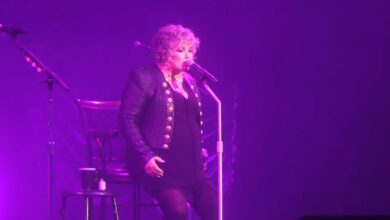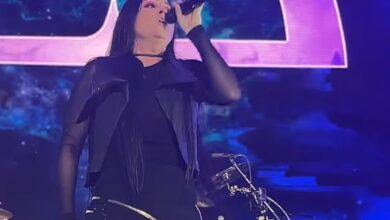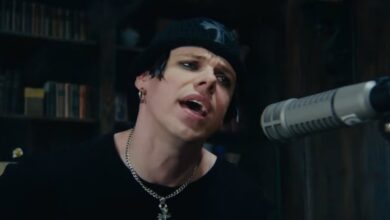Ace Frehley’s Unmatched Vibrato Shines in KISS’s “New York Groove” Brooklyn Bridge Performance
The Brooklyn Bridge show of 1996 wasn’t just another live performance—it was a thunderous homecoming. KISS returned to their birthplace, New York City, and did it in the most cinematic way possible. Beneath the glowing skyline and the hum of the East River, the four original members—Paul Stanley, Gene Simmons, Ace Frehley, and Peter Criss—turned the bridge into their own private coliseum. The occasion was the MTV Video Music Awards, and while the rest of the show unfolded indoors, KISS took over the city itself.
By the time the cameras cut to Brooklyn, the atmosphere was electric. The band had reunited that same year for their massive Alive/Worldwide tour, donning their original makeup for the first time in nearly two decades. The Brooklyn Bridge performance became a statement piece, a way of saying, “We’re not just back—we’re bigger than ever.” For a few minutes, the city that birthed them became both stage and audience.
From the first flicker of fireworks to the opening chords, it was clear that this wasn’t a regular TV slot—it was an event. The crowd pressed up against the waterfront, cheering as the band emerged through smoke and flashing lights. Against the backdrop of the Manhattan skyline, they looked larger than life, four shadows of pure spectacle carved into the New York night.
And then came the song that made it timeless: “New York Groove.” The perfect anthem for the moment, it was Ace Frehley’s love letter to the city that shaped him. His 1978 solo hit came roaring back to life that night, echoing across the water with swagger and charm. As Ace launched into the opening riff, it was as if the entire city exhaled—this was his song, his city, his night.
There was something poetic about hearing “New York Groove” under the bridge. The lyrics, the rhythm, the beat—they all felt tailor-made for the surroundings. Ace didn’t just play the song; he embodied it. Every note shimmered with pride, mischief, and a sense of belonging. The Spaceman had come home, and the city welcomed him like a hero.
The sound itself was pure adrenaline. Gene Simmons’s bass lines thundered like subway trains beneath the river, while Paul Stanley’s rhythm guitar sliced clean through the night air. Peter Criss, perched behind his kit, kept the groove locked and steady. And Ace—grinning under his silver paint—delivered one of the tightest, most joyful solos of his career. It wasn’t just technically perfect; it felt alive.
The performance had an edge that made it unforgettable. The fireworks bursting over the skyline, the reflections dancing on the water, and the crowd’s chant of “KISS! KISS! KISS!” turned the moment into living mythology. For fans watching at home, it was a perfect blend of nostalgia and raw power—a band reclaiming its crown in the city where it all began.
What made the night even more special was the chemistry. The four original members, once divided by egos and decades, played like a single heartbeat. Every grin between Paul and Ace, every sideways glance between Gene and Peter, felt like history being rewritten in real time. For a few minutes, they weren’t business partners or estranged icons—they were brothers.
Fans who were lucky enough to be there still talk about the sound of the bridge vibrating with every drum hit, the smell of gunpowder from the pyrotechnics, and the surreal glow of the city reflecting off the river. It wasn’t just a concert—it was a sensory overload, a New York moment that no one could replicate.
The decision to perform under the Brooklyn Bridge was genius. It turned a television broadcast into something cinematic, something that could only happen once. The bridge became part of the performance—a massive steel cathedral echoing with music, smoke, and light. Even those watching from rooftops across the water said they could feel it in their bones.
“New York Groove” wasn’t just a song that night—it was a declaration. It said that KISS wasn’t a relic of the past but a living, breathing force that still owned the stage. Ace Frehley stood at the center of it all, his grin wide, his Les Paul shimmering like chrome in the spotlight. It was his moment, his masterpiece, and for many, the best live version of the song ever captured.
Now, with Ace Frehley’s passing in 2025, that performance has taken on a whole new meaning. Watching him on that stage—alive with energy, playful, unstoppable—feels like watching a time capsule of everything he was. The swagger, the humor, the spark of chaos—they’re all there. The Spaceman didn’t just play guitar that night; he turned New York into music.
Since his death, fans have flooded social media with clips from the Brooklyn Bridge show, calling it “the night Ace became eternal.” And it’s true. When he tore into that solo with fireworks exploding behind him, it was as if the universe itself was in sync. Every bend of his guitar string feels heavier now, every grin a goodbye we didn’t realize we were seeing.
Looking back, it’s hard to imagine a more perfect farewell in retrospect. He wasn’t sick, he wasn’t fading—he was in his prime, doing what he loved most, in the city that raised him. The performance now stands as both celebration and memorial: the night Ace Frehley reminded the world that rock and roll isn’t about perfection—it’s about soul.
The Brooklyn Bridge 1996 performance remains one of KISS’s greatest televised moments, a blend of spectacle, nostalgia, and hometown pride. It captured the band at their tightest and the city at its most alive. And for Ace, it was destiny fulfilled—a hometown kid turned legend, returning to the bridge that spanned his past and future.
Nearly three decades later, the lights have dimmed, but the energy of that night still burns. Watch it now, and you’ll feel it—the pulse of New York, the roar of the crowd, and the unshakable grin of a man who knew he’d already become immortal. The Spaceman may have left the earth, but his groove will echo forever across the skyline he loved.





